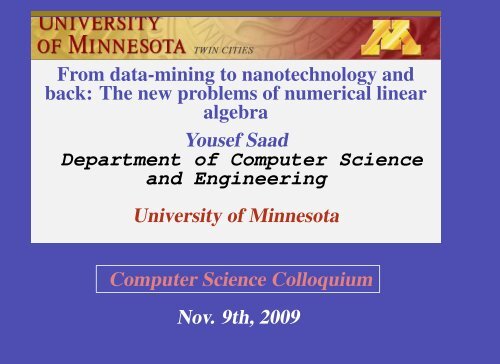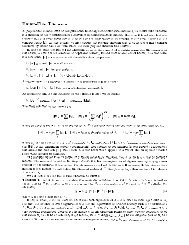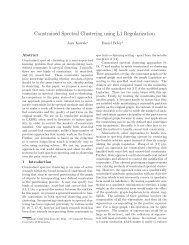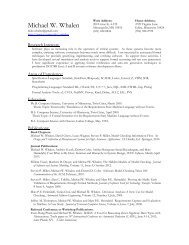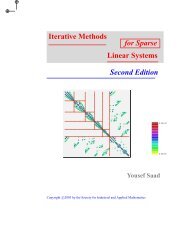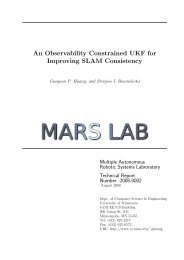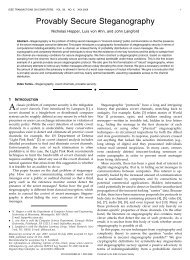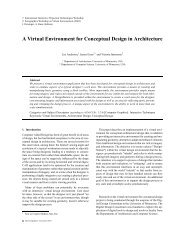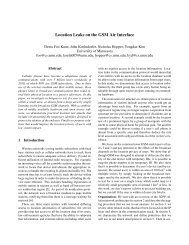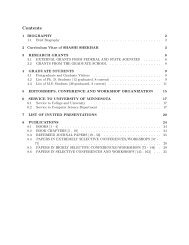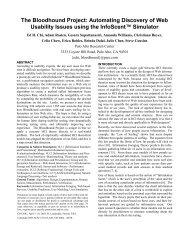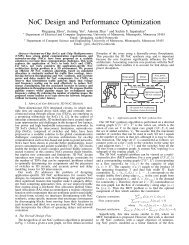Yousef Saad Department Of Computer Science And Engineering
Yousef Saad Department Of Computer Science And Engineering
Yousef Saad Department Of Computer Science And Engineering
Create successful ePaper yourself
Turn your PDF publications into a flip-book with our unique Google optimized e-Paper software.
From data-mining to nanotechnology and<br />
back: The new problems of numerical linear<br />
algebra<br />
<strong>Yousef</strong> <strong>Saad</strong><br />
<strong>Department</strong> of <strong>Computer</strong> <strong>Science</strong><br />
and <strong>Engineering</strong><br />
University of Minnesota<br />
<strong>Computer</strong> <strong>Science</strong> Colloquium<br />
Nov. 9th, 2009
Introduction<br />
Numerical linear algebra has always been a “universal” tool<br />
in science and engineering. Its focus has changed over the<br />
years to tackle “new challenges”<br />
1940s–1950s: Major issue: the flutter problem in aerospace<br />
engineering. Focus: eigenvalue problem.<br />
➤ Then came the discoveries of the LR and QR algorithms,<br />
and the package Eispack followed a little later<br />
1960s: Problems related to the power grid promoted what<br />
we know today as general sparse matrix techniques.<br />
Late 1980s – 1990s: Focus on parallel matrix computations.<br />
Late 1990s: Big spur of interest in “financial computing” [Focus:<br />
Stochastic PDEs]<br />
CSE Colloquium 11/09/09 p. 2
➤ Then the stock market tanked .. and numerical analysts<br />
returned to more mundaine basics<br />
Recent/Current: Google page rank, data mining, problems<br />
related to internet technology, knowledge discovery, bio-informatics,<br />
nano-technology, ...<br />
➤ Major new factor: Synergy between disciplines.<br />
Example: Discoveries in materials (e.g. semi conductors<br />
replacing vacuum tubes in 1950s) lead to faster computers,<br />
which in turn lead to better physical simulations..<br />
➤ What about data-mining and materials?<br />
➤ Potential for a perfect union...<br />
CSE Colloquium 11/09/09 p. 3
NUMERICAL LINEAR ALGEBRA IN ELECTRONIC STRUCTURE
Electronic structure<br />
➤ Quantum mechanics: Single biggest scientific achievement<br />
of 20th century. See<br />
Thirty years that shook physics, George Gamov, 1966<br />
➤ “There is plenty of room at the bottom” [Feynman, 1959]<br />
– started the era of nanotechnology [making materials with<br />
specific properties.]<br />
see http://www.zyvex.com/nanotech/feynman.html<br />
➤ Examples of applications: Superhard materials, superconductors,<br />
drug design, efficient photovoltaic cells, ...<br />
➤ All these need as a basic tool: computational methods to<br />
determine electronic structure.<br />
CSE Colloquium 11/09/09 p. 5
Electronic structure and Schrödinger’s equation<br />
➤ Basic and essential tool for simulations at the nano-scale.<br />
➤ Determining matter’s electronic structure can be a major<br />
challenge:<br />
Number of particules is large [a macroscopic amount<br />
contains ≈ 10 23 electrons and nuclei] and the physical<br />
problem is intrinsically complex.<br />
➤ Solution via the many-body Schrödinger equation:<br />
HΨ = EΨ<br />
➤ In its original form the above equation is very complex<br />
CSE Colloquium 11/09/09 p. 6
➤ Hamiltonian H is of the form :<br />
H = − <br />
i<br />
− <br />
i,j<br />
2 ∇ 2 i<br />
2Mi<br />
Zie 2<br />
− <br />
| Ri − rj|<br />
j<br />
+ 1<br />
2<br />
2 ∇ 2 j<br />
2m<br />
<br />
i,j<br />
+ 1<br />
2<br />
<br />
i,j<br />
e2 |ri − rj|<br />
ZiZje 2<br />
| Ri − Rj|<br />
➤ Ψ = Ψ(r1, r2, . . . , rn, R1, R2, . . . , RN) depends on coordinates<br />
of all electrons/nuclei.<br />
➤ Involves sums over all electrons / nuclei and their pairs<br />
➤ Note: ∇ 2 i Ψ is Laplacean of Ψ w.r.t. variable ri. Represents<br />
kinetic energy for i-th particle.<br />
CSE Colloquium 11/09/09 p. 7
A hypothetical calculation: [with a “naive approach”]<br />
➤ 10 Atoms each having 14 electrons [Silicon]<br />
➤ ... a total of 15*10= 150 particles<br />
➤ ... Assume each coordinate will need 100 points for discretization..<br />
➤ ... you will get<br />
# Unknowns = 100<br />
<br />
part.1<br />
× 100<br />
<br />
part.2<br />
× · · · × 100<br />
<br />
part.150<br />
= 100 150<br />
➤ Methods based on this basic formulation are limited to a<br />
few atoms – useless for real compounds.<br />
CSE Colloquium 11/09/09 p. 8
The underlying physical laws necessary for the mathematical<br />
theory of a large part of physics and the whole chemistry<br />
are thus completely known, and the difficulty is only that the<br />
exact application of these laws leads to equations much too<br />
complicated to be soluble. It therefore becomes desirable<br />
that approximate practical methods of applying quantum<br />
mechanics should be developed, which can lead to the<br />
explanation of the main features of complex atomic systems<br />
without too much computations. Dirac, 1929<br />
➤ In 1929 quantum mechanics was basically understood<br />
➤ Today the “desire” to have approximate practical methods<br />
is still alive<br />
CSE Colloquium 11/09/09 p. 9
Several approximations/theories used<br />
➤ Born-Oppenheimer approximation: Neglect motion of nuclei<br />
[Much heavier than electrons]<br />
➤ Replace many electrons by one electron systems: each<br />
electron sees only average potentials from other particles<br />
➤ Density Functional Theory [Hohenberg-Kohn ’65]: Observables<br />
determined by ground state charge density<br />
➤ Consequence: Equation of the form<br />
<br />
− h2<br />
2m ∇2 + v0(r) + VH + Vxc<br />
<br />
Ψ = EΨ<br />
➤ v0 = external potential, Exc = exchange-correlation energy<br />
CSE Colloquium 11/09/09 p. 10
Kohn-Sham equations → nonlinear eigenvalue Pb<br />
<br />
− 1<br />
2 ∇2 <br />
+ (Vion + VH + Vxc)<br />
Ψi = EiΨi, i = 1, ..., no<br />
ρ(r) =<br />
➤ Both Vxc and VH, depend on ρ.<br />
no <br />
i<br />
|Ψi(r)| 2<br />
∇ 2 VH = −4πρ(r)<br />
➤ Potentials & charge densities must be self-consistent.<br />
➤ Broyden-type quasi-Newton technique used<br />
➤ Typically, a small number of iterations are required<br />
➤ Most time-consuming part: diagonalization<br />
CSE Colloquium 11/09/09 p. 11
Real-space Finite Difference Methods<br />
➤ Use High-Order Finite Difference Methods [Fornberg &<br />
Sloan ’94]<br />
➤ Typical Geometry = Cube – regular structure.<br />
➤ Laplacean matrix need not even be stored.<br />
Order 4 Finite Difference<br />
Approximation:<br />
z<br />
CSE Colloquium 11/09/09 p. 12<br />
y<br />
x
The physical domain<br />
CSE Colloquium 11/09/09 p. 13
Computational code: PARSEC; Milestones<br />
• PARSEC = Pseudopotential Algorithm for Real Space Electronic<br />
Calculations<br />
• Sequential real-space code on Cray YMP [up to ’93]<br />
• Cluster of SGI workstations [up to ’96]<br />
• CM5 [’94-’96] Massive parallelism begins<br />
• IBM SP2 [Using PVM]<br />
• Cray T3D [PVM + MPI] ∼ ’96; Cray T3E [MPI] – ’97<br />
• IBM SP with +256 nodes – ’98+<br />
• SGI Origin 3900 [128 processors] – ’99+<br />
• IBM SP + F90 - PARSEC name given, ’02<br />
• PARSEC released in ∼ 2005.<br />
CSE Colloquium 11/09/09 p. 14
CHEBYSHEV FILTERING
Diagonalization via Chebyshev filtering<br />
Given a basis [v1, . . . , vm], ’fil- ˆvi = pk(A)vi<br />
ter’ each vector as<br />
➤ pk = Low deg. polynomial. Dampens unwanted components<br />
➤ Filtering step not used to<br />
compute eigenvectors accurately<br />
➤ In effect: SCF & diagonalization<br />
loops merged<br />
Convergence well preserved<br />
1<br />
0.8<br />
0.6<br />
0.4<br />
0.2<br />
0<br />
Deg. 8 Cheb. polynom., on interv.: [−11]<br />
−1 −0.5 0 0.5 1<br />
Yunkai Zhou, Y.S., Murilo L. Tiago, and James R. Chelikowsky,<br />
Phys. Rev. E, vol. 74, p. 066704 (2006).<br />
CSE Colloquium 11/09/09 p. 16
Chebyshev Subspace iteration - experiments<br />
➤ A large calculation: Si9041H1860, using 48 processors [SGI<br />
Altix, Itanium proc., 1.6 GHz]<br />
➤ Hamiltonian size=2, 992, 832, Num. States= 19, 015.<br />
# A ∗ x # SCF total eV /atom 1st CPU total CPU<br />
4804488 18 -92.00412 102.12 hrs. 294.36 hrs<br />
➤ Calculation done in ∼ 2006.<br />
➤ Largest one done in 1997: Si525H276<br />
➤ Took a few days [48 h. cpu] on 64PE - Cray T3D.<br />
➤ Now 2 hours on 1 PE (!)<br />
CSE Colloquium 11/09/09 p. 17
CSE Colloquium 11/09/09 p. 18
NUMERICAL LINEAR ALGEBRA IN DATA MINING
Introduction: What is data mining?<br />
➤ Common goal of data mining methods: to extract<br />
meaningful information or patterns from data. Very broad<br />
area – includes: data analysis, machine learning, pattern<br />
recognition, information retrieval, ...<br />
➤ Main tools used: linear algebra; graph theory; approximation<br />
theory; optimization; ...<br />
➤ In this talk: brief overview with emphasis on dimension<br />
reduction techniques. interrelations between techniques, and<br />
graph theory tools.<br />
CSE Colloquium 11/09/09 p. 20
Major tool of Data Mining: Dimension reduction<br />
➤ Goal is not just to reduce computational cost but to:<br />
• Reduce noise and redundancy in data<br />
• Discover ‘features’ or ‘patterns’ (e.g., supervised learning)<br />
➤ Techniques depend on application: Preserve angles? Preserve<br />
distances? Maximize variance? ..<br />
CSE Colloquium 11/09/09 p. 21
The problem of Dimension Reduction<br />
➤ Given d ≪ m find a mapping<br />
Φ : x ∈ R m −→ y ∈ R d<br />
➤ Mapping may be explicit [typically linear], e.g.:<br />
➤ Or implicit (nonlinear)<br />
Practically:<br />
y = V T x<br />
Given: X ∈ R m×n .<br />
Want: a low-dimensional representation<br />
Y ∈ R d×n of X<br />
CSE Colloquium 11/09/09 p. 22
Linear Dimensionality Reduction<br />
Given: a data set X = [x1, x2, . . . , xn], and d the dimension<br />
of the desired reduced space Y = [y1, y2, . . . , yn].<br />
Want: A linear transformation from X to Y<br />
d<br />
m<br />
v T<br />
m<br />
X<br />
Y<br />
n<br />
x<br />
y<br />
n<br />
i<br />
i<br />
d<br />
X ∈ R m×n<br />
V ∈ R m×d<br />
Y = V ⊤ X<br />
→ Y ∈<br />
R d×n<br />
➤ m-dimens. objects (xi) ‘flattened’ to d-dimens. space (yi)<br />
Constraint: The yi’s must satisfy certain properties<br />
➤ Optimization problem<br />
CSE Colloquium 11/09/09 p. 23
Example 1: The ‘Swill-Roll’ (2000 points in 3-D)<br />
15<br />
10<br />
5<br />
0<br />
−5<br />
−10<br />
−15<br />
Original Data in 3−D<br />
−15 −10 −5 0 5 10 15<br />
−20<br />
−10<br />
0<br />
CSE Colloquium 11/09/09 p. 24<br />
10<br />
20
2-D ‘reductions’:<br />
15<br />
10<br />
5<br />
0<br />
−5<br />
−10<br />
PCA<br />
−15<br />
−20 −10 0 10 20<br />
15<br />
10<br />
5<br />
0<br />
−5<br />
−10<br />
LPP<br />
−15<br />
−15 −10 −5 0 5 10<br />
Eigenmaps ONPP<br />
CSE Colloquium 11/09/09 p. 25
Example 2: Digit images (a random sample of 30)<br />
10<br />
20<br />
10<br />
20<br />
10<br />
20<br />
10<br />
20<br />
10<br />
20<br />
5 10 15<br />
5 10 15<br />
5 10 15<br />
5 10 15<br />
5 10 15<br />
10<br />
20<br />
10<br />
20<br />
10<br />
20<br />
10<br />
20<br />
10<br />
20<br />
5 10 15<br />
5 10 15<br />
5 10 15<br />
5 10 15<br />
5 10 15<br />
10<br />
20<br />
10<br />
20<br />
10<br />
20<br />
10<br />
20<br />
10<br />
20<br />
5 10 15<br />
5 10 15<br />
5 10 15<br />
5 10 15<br />
5 10 15<br />
10<br />
20<br />
10<br />
20<br />
10<br />
20<br />
10<br />
20<br />
10<br />
20<br />
5 10 15<br />
5 10 15<br />
5 10 15<br />
5 10 15<br />
5 10 15<br />
10<br />
20<br />
10<br />
20<br />
10<br />
20<br />
10<br />
20<br />
10<br />
20<br />
5 10 15<br />
5 10 15<br />
5 10 15<br />
5 10 15<br />
5 10 15<br />
10<br />
20<br />
10<br />
20<br />
10<br />
20<br />
10<br />
20<br />
10<br />
20<br />
5 10 15<br />
5 10 15<br />
5 10 15<br />
5 10 15<br />
5 10 15<br />
CSE Colloquium 11/09/09 p. 26
2-D ’reductions’:<br />
6<br />
4<br />
2<br />
0<br />
−2<br />
−4<br />
PCA − digits : 0 −− 4<br />
−6<br />
−10 −5 0 5 10<br />
0.2<br />
0.15<br />
0.1<br />
0.05<br />
0<br />
−0.05<br />
−0.1<br />
K−PCA − digits : 0 −− 4<br />
−0.15<br />
0.07 0.071 0.072 0.073 0.074<br />
0<br />
1<br />
2<br />
3<br />
4<br />
0<br />
1<br />
2<br />
3<br />
4<br />
0.15<br />
0.1<br />
0.05<br />
0<br />
−0.05<br />
−0.1<br />
−0.15<br />
LLE − digits : 0 −− 4<br />
−0.2<br />
−0.2 −0.1 0 0.1 0.2<br />
0.1<br />
0.05<br />
0<br />
−0.05<br />
−0.1<br />
−0.15<br />
−0.2<br />
ONPP − digits : 0 −− 4<br />
−0.25<br />
−5.4341 −5.4341 −5.4341 −5.4341 −5.4341<br />
x 10 −3<br />
CSE Colloquium 11/09/09 p. 27
Unsupervised learning: Clustering<br />
Problem: partition a given set into subsets such that items<br />
of the same subset are most similar and those of two different<br />
subsets most dissimilar.<br />
Superconductors<br />
Multi−ferroics<br />
Superhard<br />
Catalytic<br />
Photovoltaic<br />
Ferromagnetic<br />
Thermo−electric<br />
➤ Basic technique: K-means algorithm [slow but effective.]<br />
➤ Example of application : cluster bloggers by ‘social groups’<br />
(anarchists, ecologists, sports-fans, liberals-conservative, ... )<br />
CSE Colloquium 11/09/09 p. 28
Sparse Matrices viewpoint<br />
* Joint work with J. Chen<br />
➤ Communities modeled by an ‘affinity’ graph [e.g., ’user A<br />
sends frequent e-mails to user B’]<br />
➤ Adjacency Graph represented<br />
by a sparse matrix<br />
➤ Goal: find ordering so blocks<br />
are as dense as possible:<br />
➤ Use ‘blocking’ techniques for sparse matrices<br />
CSE Colloquium 11/09/09 p. 29
➤ Advantage of this viewpoint: need not know # of clusters<br />
Example of application Data set from :<br />
http://www-personal.umich.edu/ ∼ mejn/netdata/<br />
➤ Network connecting bloggers of different political orientations<br />
[2004 US presidentual election]<br />
➤ ‘Communities’: liberal vs. conservative<br />
➤ Graph: 1, 490 vertices (blogs) : first 758: liberal, rest:<br />
conservative.<br />
➤ Edge: i → j : a citation between blogs i and j<br />
➤ Blocking algorithm (Density theshold=0.4): subgraphs [note:<br />
density = |E|/|V | 2 .] ➤ Smaller subgraph: conservative blogs,<br />
larger one: liberals<br />
CSE Colloquium 11/09/09 p. 30
Supervised learning: classification<br />
Problem: Given labels<br />
(say “A” and “B”) for each<br />
item of a given set, find a<br />
mechanism to classify an<br />
unlabelled item into either<br />
the “A” or the “B” class.<br />
➤ Many applications.<br />
➤ Example: distinguish SPAM and non-SPAM messages<br />
?<br />
?<br />
➤ Can be extended to more than 2 classes.<br />
CSE Colloquium 11/09/09 p. 31
Linear classifiers<br />
➤ Find a hyperplane which best separates the data in classes<br />
A and B.<br />
Linear<br />
classifier<br />
CSE Colloquium 11/09/09 p. 32
A harder case:<br />
4<br />
3<br />
2<br />
1<br />
0<br />
−1<br />
−2<br />
−3<br />
Spectral Bisection (PDDP)<br />
−4<br />
−2 −1 0 1 2 3 4 5<br />
➤ Use kernels to transform
0.1<br />
0.08<br />
0.06<br />
0.04<br />
0.02<br />
0<br />
−0.02<br />
−0.04<br />
−0.06<br />
−0.08<br />
Projection with Kernels −− σ 2 = 2.7463<br />
−0.1<br />
−0.08 −0.06 −0.04 −0.02 0 0.02 0.04 0.06<br />
Transformed data with a Gaussian Kernel<br />
CSE Colloquium 11/09/09 p. 34
Fisher’s Linear Discriminant Analysis (LDA)<br />
Define “between scatter”: a measure of how well separated<br />
two distinct classes are.<br />
Define “within scatter”: a measure of how well clustered items<br />
of the same class are.<br />
➤ Goal: to make “between scatter” measure large, while<br />
making “within scatter” small.<br />
Idea: Project the data in low-dimensional space so as to<br />
maximize the ratio of the “between scatter” measure over<br />
“within scatter” measure of the classes.<br />
CSE Colloquium 11/09/09 p. 35
Let µ = mean<br />
of X, and µ (k) =<br />
mean of the k-th<br />
class (of size nk).<br />
Define:<br />
★<br />
SB =<br />
SW =<br />
★<br />
c<br />
k=1<br />
c<br />
k=1<br />
nk(µ (k) − µ)(µ (k) − µ) T ,<br />
<br />
xi ∈Xk<br />
GLOBAL CENTROID<br />
(xi − µ (k) )(xi − µ (k) ) T .<br />
CLUSTER CENTROIDS<br />
CSE Colloquium 11/09/09 p. 36
➤ Project set on<br />
a one-dimensional<br />
space spanned by<br />
a vector a.<br />
Then:<br />
a T SBa =<br />
a T SW a =<br />
➤ LDA projects the data so as<br />
to maximize the ratio of these two<br />
numbers:<br />
c<br />
i=1<br />
c<br />
k=1<br />
nk|a T (µ (k) − µ)| 2 ,<br />
<br />
xi ∈ Xk<br />
|a T (xi − µ (k) )| 2<br />
max<br />
a<br />
a T SBa<br />
a T SW a<br />
➤ Optimal a = eigenvector associated with the largest eigenvalue<br />
of:<br />
SBui = λiSW ui .<br />
CSE Colloquium 11/09/09 p. 37
LDA – in d dimensions<br />
➤ Criterion: maximize the ratio<br />
of two traces:<br />
Tr [U T SBU]<br />
Tr [U T SW U]<br />
➤ Constraint: U T U = I (orthogonal projector).<br />
➤ Reduced dimension data: Y = U T X.<br />
Common viewpoint: hard to maximize, therefore ...<br />
➤ ... alternative: Solve instead<br />
the (‘easier’) problem:<br />
max<br />
U T SW U=I<br />
Tr [U T SBU]<br />
➤ Solution: largest eigenvectors of SBui = λiSW ui .<br />
CSE Colloquium 11/09/09 p. 38
Trace ratio problem<br />
* Joint work with Thanh Ngo and Mohamed Bellalij<br />
➤ Main point: trace ratio can be maximized inexpensively<br />
Let f(ρ) = max U,U T U=I Trace[U T (A − ρB)U]<br />
<strong>And</strong> let U(ρ) the maximizer of above trace.<br />
➤ Then, under some mild assumptions on A and B :<br />
1) Optimal ρ for trace ratio is a zero of f<br />
2) f ′ (ρ) = −Trace[U(ρ) T BU(ρ)]<br />
3) f is a decreasing function<br />
... + Newton’s method to find zero<br />
amounts to a fixed point iteration:<br />
ρnew = Tr [U(ρ)T AU(ρ)]<br />
Tr [U(ρ) T BU(ρ)]<br />
CSE Colloquium 11/09/09 p. 39
➤ Idea: Compute U(ρ) by an inexpensive Lanczos procedure<br />
➤ Note: Standard problem - [not generalized] → cheap..<br />
➤ Recent papers advocated similar or related techniques<br />
[1] C. Shen, H. Li, and M. J. Brooks, A convex programming<br />
approach to the trace quotient problem. In ACCV (2) – 2007.<br />
[2] H. Wang, S.C. Yan, D.Xu, X.O. Tang, and T. Huang. Trace<br />
ratio vs. ratio trace for dimensionality reduction. In IEEE Conference<br />
on <strong>Computer</strong> Vision and Pattern Recognition, 2007<br />
[3] S. Yan and X. O. Tang, “Trace ratio revisited” Proceedings<br />
of the European Conference on <strong>Computer</strong> Vision, 2006.<br />
...<br />
CSE Colloquium 11/09/09 p. 40
Background: The Lanczos procedure<br />
ALGORITHM : 1 Lanczos<br />
1. Choose an initial vector v1 of norm unity.<br />
Set β1 ≡ 0, v0 ≡ 0<br />
2. For j = 1, 2, . . . , m Do:<br />
3. αj := (wj, vj)<br />
4. wj := Avj − αjvj − βjvj−1<br />
5. βj+1 := wj2. If βj+1 = 0 then Stop<br />
6. vj+1 := wj/βj+1<br />
7. EndDo<br />
➤ In first few steps of Newton: rough approximation needed.<br />
CSE Colloquium 11/09/09 p. 41
INFORMATION RETRIEVAL
Information Retrieval: Vector Space Model<br />
➤ Given: a collection of documents (columns of a matrix A)<br />
and a query vector q.<br />
➤ Collection represented by an m × n term by document<br />
matrix with aij = LijGiNj<br />
➤ Queries (‘pseudo-documents’) q are represented similarly<br />
to a column<br />
CSE Colloquium 11/09/09 p. 43
Vector Space Model - continued<br />
➤ Problem: find a column of A that best matches q<br />
➤ Similarity metric: angle between the column and q - Use<br />
cosines:<br />
|c T q|<br />
c2q2<br />
➤ To rank all documents we need to compute<br />
➤ s = similarity vector.<br />
s = A T q<br />
➤ Literal matching – not very effective.<br />
CSE Colloquium 11/09/09 p. 44
Common approach: Use the SVD<br />
➤ Need to extract intrinsic information – or underlying “semantic”<br />
information –<br />
➤ LSI: replace A by a low rank approximation [from SVD]<br />
A = UΣV T → Ak = UkΣkV T<br />
k<br />
➤ Uk : term space, Vk: document space.<br />
➤ New similarity vector: sk = A T k q = VkΣkU T k<br />
➤ Main issues: 1) computational cost 2) Updates<br />
CSE Colloquium 11/09/09 p. 45
Use of polynomial filters<br />
* Joint work with E. Kokiopoulou<br />
The idea: Replace Ak by Aφ(A T A), where φ is a certain<br />
filter function<br />
Consider the step-function (Heaviside function:)<br />
<br />
2 0, 0 ≤ x ≤ σ<br />
φ(x) =<br />
k<br />
1, σ2 k ≤ x ≤ σ2 1<br />
➤ This would yield the same result as with TSVD but...<br />
➤ ... Not easy to use this function directly<br />
➤ Solution : use a polynomial approximation to φ<br />
➤ Note: s T = q T Aφ(A T A) , requires only Mat-Vec’s<br />
CSE Colloquium 11/09/09 p. 46
Polynomial filters - examples<br />
Approach: Approximate<br />
a piecewise polynom.<br />
by a polynomial in leastsquares<br />
sense<br />
➤ Ideal for situations where data must be explored once or a<br />
small number of times only –<br />
➤ Details skipped – see:<br />
E. Kokiopoulou and YS, Polynomial Filtering in Latent Semantic<br />
Indexing for Information Retrieval, ACM-SIGIR, 2004.<br />
a<br />
CSE Colloquium 11/09/09 p. 47<br />
b<br />
φ
IR: Use of the Lanczos algorithm<br />
* Joint work with Jie Chen<br />
➤ Lanczos is good at catching large (and small) eigenvalues:<br />
can compute singular vectors with Lanczos, & use them in LSI<br />
➤ Can do better: Use the Lanczos vectors directly for the<br />
projection..<br />
➤ Related idea: K. Blom and A. Ruhe [SIMAX, vol. 26, 2005].<br />
Use Lanczos bidiagonalization.<br />
➤ Use a similar approach – But directly with AA T or A T A.<br />
CSE Colloquium 11/09/09 p. 48
IR: Use of the Lanczos algorithm (1)<br />
➤ Let A ∈ R m×n . Apply the Lanczos procedure to M =<br />
AA T . Result:<br />
Q T k AAT Qk = Tk<br />
with Qk orthogonal, Tk tridiagonal.<br />
➤ Define si ≡ orth. projection of Ab on subspace span{Qi}<br />
si := QiQ T i Ab.<br />
➤ si can be easily updated from si−1:<br />
si = si−1 + qiq T<br />
i Ab.<br />
CSE Colloquium 11/09/09 p. 49
IR: Use of the Lanczos algorithm (2)<br />
➤ If n < m it may be more economial to apply Lanczos to<br />
M = A T A which is n × n. Result:<br />
➤ Define:<br />
¯Q T k AT A ¯Qk = ¯Tk<br />
ti := A ¯Qi ¯Q T i b,<br />
➤ Project b first before applying A to result.<br />
CSE Colloquium 11/09/09 p. 50
➤ Theory well understood: works well because Lanczos produces<br />
good approximations to dominant sing. vectors<br />
Advantages of Lanczos over polynomial filters:<br />
(1) No need for eigenvalue estimates<br />
(2) Mat-vecs performed only in preprocessing<br />
Disadvantages:<br />
(1) Need to store Lanczos vectors;<br />
(2) Preprocessing must be redone when A changes.<br />
(3) Need for reorthogonalization – expensive for large k.<br />
CSE Colloquium 11/09/09 p. 51
Tests: IR<br />
Information<br />
retrieval<br />
datasets<br />
Preprocessing times<br />
preprocessing time<br />
90<br />
80<br />
70<br />
60<br />
50<br />
40<br />
30<br />
20<br />
10<br />
lanczos<br />
tsvd<br />
# Terms # Docs # queries sparsity<br />
MED 7,014 1,033 30 0.735<br />
CRAN 3,763 1,398 225 1.412<br />
Med dataset.<br />
Med<br />
0<br />
0 50 100 150 200 250 300<br />
iterations<br />
preprocessing time<br />
60<br />
50<br />
40<br />
30<br />
20<br />
10<br />
lanczos<br />
tsvd<br />
Cran dataset.<br />
Cran<br />
0<br />
0 50 100 150 200 250 300<br />
iterations<br />
CSE Colloquium 11/09/09 p. 52
Average query times<br />
average query time<br />
4.5<br />
4<br />
3.5<br />
3<br />
2.5<br />
2<br />
1.5<br />
1<br />
0.5<br />
x Med<br />
10−3<br />
5<br />
lanczos<br />
tsvd<br />
lanczos−rf<br />
tsvd−rf<br />
Med dataset<br />
0<br />
0 50 100 150 200 250 300<br />
iterations<br />
average query time<br />
3.5<br />
3<br />
2.5<br />
2<br />
1.5<br />
1<br />
0.5<br />
x Cran<br />
10−3<br />
4<br />
lanczos<br />
tsvd<br />
lanczos−rf<br />
tsvd−rf<br />
Cran dataset.<br />
0<br />
0 50 100 150 200 250 300<br />
iterations<br />
CSE Colloquium 11/09/09 p. 53
Average retrieval precision<br />
average precision<br />
0.9<br />
0.8<br />
0.7<br />
0.6<br />
0.5<br />
0.4<br />
0.3<br />
0.2<br />
0.1<br />
Med dataset<br />
Med<br />
0<br />
0 50 100 150 200 250 300<br />
iterations<br />
lanczos<br />
tsvd<br />
lanczos−rf<br />
tsvd−rf<br />
Cran dataset<br />
Retrieval precision comparisons<br />
average precision<br />
0.9<br />
0.8<br />
0.7<br />
0.6<br />
0.5<br />
0.4<br />
0.3<br />
0.2<br />
0.1<br />
Cran<br />
0<br />
0 100 200 300 400 500 600<br />
iterations<br />
lanczos<br />
tsvd<br />
lanczos−rf<br />
tsvd−rf<br />
CSE Colloquium 11/09/09 p. 54
In summary:<br />
➤ Results comparable to those of SVD ...<br />
➤ .. at a much lower cost.<br />
Thanks:<br />
➤ Helpful tools and datasets widely available. We used TMG<br />
[developed at the U. of Patras (D. Zeimpekis, E. Gallopoulos)]<br />
CSE Colloquium 11/09/09 p. 55
Face Recognition – background<br />
Problem: We are given a database of images: [arrays of<br />
pixel values]. <strong>And</strong> a test (new) image.<br />
ÿ ÿ ÿ ÿ ÿ ÿ<br />
↖ ↑ ↗<br />
Question: Does this new image correspond to one of those<br />
in the database?<br />
CSE Colloquium 11/09/09 p. 56
Difficulty Positions, Expressions, Lighting, ...,<br />
Eigenfaces: Principal Component Analysis technique<br />
➤ Specific situation: Poor images or deliberately<br />
altered images [‘occlusion’]<br />
➤ See real-life examples – [international<br />
man-hunt]<br />
CSE Colloquium 11/09/09 p. 57
Eigenfaces<br />
– Consider each picture as a (1-D) column of all pixels<br />
– Put together into an array A of size # pixels×# images.<br />
. . . =⇒ . . .<br />
<br />
A<br />
– Do an SVD of A and perform comparison with any test image<br />
in low-dim. space<br />
– Similar to LSI in spirit – but data is not sparse.<br />
Idea: replace SVD by Lanczos vectors (same as for IR)<br />
CSE Colloquium 11/09/09 p. 58
Tests: Face Recognition<br />
Tests with 2 well-known data sets:<br />
ORL 40 subjects, 10 sample images each – example:<br />
# of pixels : 112 × 92 TOT. # images : 400<br />
AR set 126 subjects – 4 facial expressions selected for each<br />
[natural, smiling, angry, screaming] – example:<br />
# of pixels : 112 × 92 # TOT. # images : 504<br />
CSE Colloquium 11/09/09 p. 59
Tests: Face Recognition<br />
Recognition accuracy of Lanczos approximation vs SVD<br />
ORL dataset<br />
AR dataset<br />
average error rate<br />
1<br />
0.9<br />
0.8<br />
0.7<br />
0.6<br />
0.5<br />
0.4<br />
0.3<br />
0.2<br />
0.1<br />
ORL<br />
0<br />
0 10 20 30 40 50 60 70 80 90 100<br />
iterations<br />
lanczos<br />
tsvd<br />
average error rate<br />
1<br />
0.9<br />
0.8<br />
0.7<br />
0.6<br />
0.5<br />
0.4<br />
0.3<br />
0.2<br />
0.1<br />
AR<br />
0<br />
0 10 20 30 40 50 60 70 80 90 100<br />
iterations<br />
lanczos<br />
tsvd<br />
Vertical axis shows average error rate. Horizontal = Subspace<br />
dimension<br />
CSE Colloquium 11/09/09 p. 60
GRAPH-BASED METHODS
Graph-based methods<br />
➤ Start with a graph of data. e.g.:<br />
graph of k nearest neighbors (k-NN<br />
graph)<br />
Want: Do a projection so as to preserve<br />
the graph in some sense<br />
➤ Define a graph Laplacean:<br />
e.g.,: wij =<br />
L = D − W<br />
1 if j ∈ Ni<br />
0 else<br />
with Ni = neighborhood of i (excl. i)<br />
D = diag<br />
⎡<br />
x<br />
i<br />
x j<br />
y i<br />
⎣dii = <br />
j=i<br />
y j<br />
wij<br />
⎤<br />
⎦<br />
CSE Colloquium 11/09/09 p. 62
Example: The Laplacean eigenmaps<br />
Laplacean Eigenmaps [Belkin & Niyogi’02] *minimizes*<br />
FEM(Y ) =<br />
n<br />
wijyi −yj 2<br />
subject to Y DY ⊤ = I<br />
Notes:<br />
i,j=1<br />
1. Motivation: if xi − xj is small<br />
(orig. data), we want yi − yj to be<br />
also small (low-dim. data)<br />
2. Note: Min instead of Max as in PCA<br />
[counter-intuitive]<br />
3. Above problem uses original data<br />
indirectly through its graph<br />
x<br />
i<br />
x j<br />
CSE Colloquium 11/09/09 p. 63<br />
y i<br />
y j
➤ Problem translates to:<br />
⎧<br />
⎨<br />
⎩<br />
min<br />
Y ∈ R d×n<br />
Y D Y ⊤ = I<br />
Tr Y (D − W )Y ⊤ .<br />
➤ Solution (sort eigenvalues increasingly):<br />
(D − W )ui = λiDui ; yi = u ⊤ i<br />
; i = 1, · · · , d<br />
➤ An n × n sparse eigenvalue problem [In ‘sample’ space]<br />
➤ Note: can assume D = I. Amounts to rescaling data.<br />
Problem becomes<br />
(I − W )ui = λiui ; yi = u ⊤ i<br />
; i = 1, · · · , d<br />
CSE Colloquium 11/09/09 p. 64
A unified view<br />
* Joint work with Efi Kokiopoulou and J. Chen<br />
➤ Most techniques lead to one of two types of problems<br />
First :<br />
➤ Y results directly<br />
from computing eigenvectors<br />
➤ LLE, Eigenmaps, ...<br />
Second:<br />
➤ Low-Dimens. data:<br />
Y = V ⊤ X<br />
➤ G == identity, or<br />
XDX ⊤ , or XX ⊤<br />
⎧<br />
⎨<br />
⎩<br />
⎧<br />
⎨<br />
⎩<br />
min<br />
Y ∈ R d×n<br />
Y Y ⊤ = I<br />
min<br />
V ∈ R m×d<br />
V ⊤ G V = I<br />
Tr Y MY ⊤<br />
Tr V ⊤ XMX ⊤ V <br />
Observation: 2nd is just a projected version of the 1st.<br />
CSE Colloquium 11/09/09 p. 65
Computing k-nn graphs<br />
* Joint work with J. Chen and H. R. Fang<br />
➤ Main idea: Divide and Conquer<br />
➤ 2-nd smallest eigenvector roughly<br />
separates set in two.<br />
➤ Recursively divide + handle interface<br />
with care<br />
➤ Again exploit Lanczos!<br />
X1<br />
X1 X2<br />
hyperplane<br />
hyperplane<br />
➤ Cost: O(n 1+δ ), δ depends on parameters. Less than<br />
O(n 2 ) but higher than O(n log n)<br />
➤ C-implementation [J. Chen] publically available [GPL]<br />
X3<br />
X2<br />
CSE Colloquium 11/09/09 p. 66
Graph-based methods in a supervised setting<br />
➤ Subjects of training set are known (labeled). Q: given a test<br />
image (say) find its label.<br />
Z. Dostal<br />
Z. Dostal<br />
Z. Dostal<br />
Z. Dostal<br />
R. Blaheta<br />
R. Blaheta<br />
ÿ ÿ ÿ ÿ ÿ ÿ ÿ ÿ ÿ ÿ ÿ ÿ<br />
R. Blaheta<br />
↖ ↑ ↗<br />
R. Blaheta<br />
Z. Strakos<br />
Z. Strakos<br />
Question: Find label (best match) for test image.<br />
Z. Strakos<br />
Z. Strakos<br />
CSE Colloquium 11/09/09 p. 67
Methods can be adapted to supervised mode by building the<br />
graph to use class labels. Idea: Build G so that nodes in the<br />
same class are neighbors. If c = # classes, G consists of c<br />
cliques.<br />
➤ Matrix W is block-diagonal<br />
W =<br />
⎛<br />
⎜<br />
⎝<br />
W1<br />
W2<br />
➤ Note: rank(W ) = n − c.<br />
W3<br />
➤ Can be used for LPP, ONPP, etc..<br />
W4<br />
W5<br />
⎞<br />
⎟<br />
⎠<br />
CSE Colloquium 11/09/09 p. 68
Repulsion Laplaceans<br />
* Joint work with E. Kokiopoulou (’09)<br />
➤ Idea: Create repulsion forces (energies) between items that<br />
are close but *not* in the same class.<br />
Class 1 Class 2<br />
Class 3<br />
0.98<br />
0.96<br />
0.94<br />
0.92<br />
0.9<br />
0.88<br />
0.86<br />
0.84<br />
0.82<br />
ORL −− TrainPer−Class=5<br />
onpp<br />
pca<br />
olpp−R<br />
laplace<br />
fisher<br />
onpp−R<br />
olpp<br />
0.8<br />
10 20 30 40 50 60 70 80 90 100<br />
CSE Colloquium 11/09/09 p. 69
Data mining for materials: Materials Informatics<br />
➤ Huge potential in exploiting two trends:<br />
1 Enormous improvements in efficiency and capabilities in<br />
computational methods for materials<br />
2 Recent progress in data mining techniques<br />
➤ For example, cluster materials into classes according to<br />
properties, types of atomic structures (‘point groups’) ...<br />
➤ Current practice: “One student, one alloy, one PhD” →<br />
Slow pace of discovery<br />
➤ Data Mining: help speed-up process - look at more promising<br />
alloys<br />
CSE Colloquium 11/09/09 p. 70
Materials informatics at work. Illustrations<br />
➤ 1970s: Data Mining “by hand”: Find coordinates<br />
to cluster materials according to structure<br />
➤ 2-D projection from physical knowledge<br />
see: J. R. Chelikowsky, J. C.<br />
Phillips, Phys Rev. B 19 (1978).<br />
➤ ‘Anomaly Detection’:<br />
helped find that compound Cu<br />
F does not exist<br />
CSE Colloquium 11/09/09 p. 71
Example 1: [Norskov et al., ’03, ...]<br />
• Use of genetic algorithms to ‘search’ through database of<br />
binary materials. Lead to discovery of a promising catalytic<br />
material with low cost.<br />
Example 2 : [Curtalano et al. PRL vol 91, 1003]<br />
➤ Goal: narrow search to do fewer<br />
electronic structures calculations<br />
➤ 55 binary metallic alloys considered<br />
in 114 crystal structures<br />
➤ Observation: Energies of different<br />
crystal structures are correlated<br />
➤ Use PCA: 9 dimensions good<br />
enough to yield OK accuracy –<br />
Structures (114)<br />
Alloys<br />
(55)<br />
energies<br />
CSE Colloquium 11/09/09 p. 72
Conclusion<br />
➤ Many, many, interesting New matrix problems related to the<br />
new economy and new emerging scientific fields:<br />
1 Information technologies [learning, data-mining, ...]<br />
2 Computational Chemistry / materials science<br />
3 Bio-informatics: computational biology, genomics, ..<br />
➤ Important: Many resources for data-mining available online:<br />
repositories, tutorials, Very easy to get started<br />
➤ Materials informatics very likely to become a major force<br />
➤ For a few recent papers and pointers visit my web-site at<br />
www.cs.umn.edu/∼saad<br />
CSE Colloquium 11/09/09 p. 73
When one door closes, another opens; but we often look so<br />
long and so regretfully upon the closed door that we do not<br />
see the one which has opened for us.<br />
Alexander Graham Bell (1847-1922)<br />
Thank you !<br />
CSE Colloquium 11/09/09 p. 74


